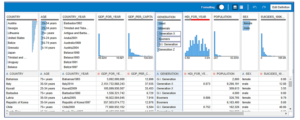
Oracle Analytics Cloud: Everything But the Kitchen Sink

Oracle is taking a “more is more” approach with the latest release of Oracle Analytics Cloud, its do-everything analytics and ML platform. Need explainable machine learning? How about graph analytics? Automated data prep? NLP? Oracle has it all–plus a new mobile app–in the new release.
Oracle has grown the feature set considerably with OAC version 6.0, which the company announced today. That means more data sources (JDBC and Google BigQuery connections are among the 50 data connectors available in the cloud or on prem); more users (business analysts, data engineers, citizen data scientists, departmental managers, domain experts, and executives are the projected users); and of course more capabilities (the options above are just a partial list).
Analytics and ML workflows typically start with data access, discovery, and preparation tasks, and OAC 6.0 brings enhancements to this field. Specifically, OAC sports a new data profiling engine that uses ML to identify problematic data. The offering generates a visualization that shows insights automatically generated from the data, such as missing values or misspellings. The software also automates data enrichment, such as by suggesting data sets to join.
ML projects can go more smoothly with new explainability functions in OAC 6.0. According to Oracle’s press release, the software can now explain what were the major factors that influenced a decision, such as denial of a bank loan.
Oracle also added text analytics to OAC with this release, enabling users to get insight out of unstructured text. This can be used for performing sentiment analysis on any textual data, among other use cases.
Separately, support for Natural Language Processing (NLP) gives users a new way to interact with OAC data. Oracle says the software supports 28 languages, and that users can speak or type their questions to OAC, such as “what’s our employee churn this month?” and the product will generate the answer.
You can also run graph analytics with the OAC update. According to Oracle’s OAC 6.0 announcement letter, the company has made a new Graph Network Viz available in the Oracle Analytics Library extensions. The company says this will simplify the use of graph analytics for various use cases, including security and marketing.
The new release also supports new affinity analysis capabilities, which allows you to “discover relationships in your data by identifying sets of items that often appear together,” the company says in its press release.” This data mining technique will be useful for market basket analysis, among other use cases.
OAC 6.0 brings new custom map analytics features that will allow you to use custom images as map backgrounds and create different map layers in a data viz. The map analytics function isn’t limited to geographical data; Oracle says it can also be used by doctors, for instance, to highlight (in an image) a part of a person’s body that need extra attention.
Finally, Oracle has delivered a new mobile app with OAC. Big Red says the new app leverages the new natural language generation (NLG) capabilities and augmented analytics in the OAC platform. It also integrates with the OAC data catalog to let you interact with data visualization and dashboards. The new app also provides a user experience that’s consistent with Oracle Analytics new “Redwood” design.
According to its roadmap document for OAC, Oracle has plans for more enhancements in the second half of the year, including a new JSON-based connector for REST APIs; a new Web-based semantic modeler that allows you to create semantic layers on top of federated data sources; introduction of the new Semantic Model Market Language (SMML) to go along with the new semantic modeler; and automated discovery of insights.
Related Items:
Oracle Touts an Exadata Backlog
Oracle Sees AI Advancing Finance, Supply Chains
Oracle Rolls Out ‘Autonomous Data Warehouse’




























